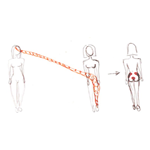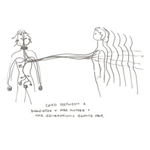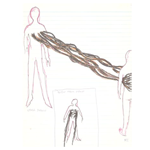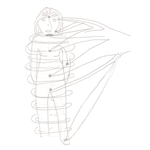To buy the book in print form or as an ebook online now, click here.
-
About the book
This is a book about relationships and how a connection which begins in love and caring might end up full of anger, resentment, fear, blame and pain.
AvrilCarruthers FreedomFromToxicRelationshipsIn short, how our love can become toxic.
It happens without our being aware of it. Toxic connections can create misery because often we feel so bound by shared history, or maybe our perceived duty, that we believe we cannot, or should not, let go. We feel too attached and it can limit our expression of who we are.
We can become affected by someone else’s emotion, even from a distance. A toxic connection carries unconscious, uncomfortable emotions between us, and can cloud our ability to relate in the present, as we would like to.
The book examines the process of attachment from the womb, and how different parenting styles can affect children. These can affect relationships in adulthood, and our own parenting style.
We can break a cycle if we become aware of what is happening. We can become aware of the difference between our own energy – our own emotional state – and others’. We can learn to separate, and differentiate ourselves as individuals. It means we can then enter into relationships more fully, without fear of being overwhelmed or hurt beyond repair.
We can give and take with a full heart in equal, loving relationships.
-
Cord drawings from clients
An adjunct to the book Freedom From Toxic Relationships Allen & Unwin, 2011.
In the process of exploring a cord, I often ask clients to draw what they feel or see between themselves and the other person. As they feel, see with their inner eye or experience the toxic connection between them, what the client observes becomes more defined and separated from the client’s energy. It’s a way to objectify the cord, and so the client becomes less affected by the toxic emotion carried in the connection. There is a huge variety in the way people see them and draw them. It’s an intensely individual thing.
In the diagram below, note how the cord changed during the observation period.
 A drawing of a mother-daughter cord showing how the cord becomes more defined and localised through the period of observation. The figure on the right is the final view before clearing. Note that it appears that there is no longer a cord.
A drawing of a mother-daughter cord showing how the cord becomes more defined and localised through the period of observation. The figure on the right is the final view before clearing. Note that it appears that there is no longer a cord.In the drawing below, Samantha drew a cord that went back generations in her family.

Samantha’s cord with her ancestors. pp. 173-174 of the book.

Maura’s cord with her mother. pp. 85-89 of the book.

A cord that binds the daughter and at the same time feeds from her energy centres.
The examples above depict just four ways people see their cords. They can be fleshy in form, like an umbilicus, a tentacle (or several) or an extended limb such as a hand. Other cords look like tree branches or roots, brambles, suckers, tumble weeds, or vines with several strands. There are cords that look and feel like barbed wire or electrical cord and others depicted as hoses, tubes or pipes of varying sizes. Cords can also be seen or felt as very fine connections of light or energy.
Click here to download this article in entirety as a PDF
-
Frequently Asked Questions
1. How would you define a toxic relationship?
A toxic relationship is one in which there is an imbalance of power maintained by control or manipulation. It can be emotionally, verbally, physically or sexually abusive, but the identifying feature is that one or both people in the relationship feel trapped and unable to detach from the strong connection they have with the other.
2. How do we get ourselves into these relationships?
Generally we inherit relating styles from our carers in early childhood. Neediness, abandonment issues and inadequate or ineffective parenting we received can predispose us to accepting any relationship, even an abusive one, rather than being alone.
3. Does your book show a way of avoiding or permanently freeing ourselves from toxic relationships?
The book is designed to bring awareness to those who might suspect they are in a toxic relationship. With insight we can begin to free ourselves. Therapeutic help is also available to those who wish to eradicate deeply bonded toxic ties.
4. Is there such a thing as love at first sight?
Yes, however, it’s good to be aware that we attract people based on the personal energy we are in. If we are emotionally and mentally healthy, we are more likely to attract partners who are also healthy. Likewise, if we are unhappy or trapped in operating through mind games simply because of early conditioning, we can attract lovers who are similar or who take advantage of our disempowerment. This means that discernment is essential in situations of ‘love at first sight’! Whatever the attraction, it will be something we can learn from, and become wiser as we move on, whether the lessons are painful or joyous and expansive.
5. What about soul mates?
Since we are evolving beings there are many soul mates who are lovingly willing and able to help both of us evolve at different stages of our growth, for varying periods of time. There is not one single soul mate for each person – we can connect with others on many profoundly meaningful levels.
6. What constitutes an ideal relationship and is it actually possible?
An ideal relationship is one of equality, of mutual respect, consideration, understanding, and of course, communication, liking and love. Many of us choose relationships for reasons other than whether it is viable or anywhere near ideal – but from neediness or loneliness, leading to abuse or disempowerment. An ideal partnership is one in which we are interdependent: independent individuals who can also interact lovingly and supportively with our partner.
-
Read an excerpt
Introduction
Transpersonal psychotherapy, the context in which this book is based, often includes meditative states and energy work—the sensing of flows of energy linked to emotional states. Deep spaces of perception and receptivity give access to extraordinary vision. They are not things we normally see with everyday eyes. In fact, in the cold light of commonly agreed-upon reality, some people find it hard to reconcile what they have themselves experienced in spaces of deep awareness. This is particularly the case from the viewpoint of Western science-based education and the dominance of left-brain logic and physical evidence.
For others, the memory of what they have seen and felt in their deeper knowingness convinces them that reality is not always as it appears on the surface. The profound transformations that emerge from these experiences are proof of their value and their meaning. We might hesitate to mention our very personal inner reality, but it doesn’t mean it’s not real, and many might relate to the stories in this book.
Our own particular inner landscape might be a place of safety and connection or, at times, a dark, lonely abyss in which we feel cut off, abandoned, unseen or unrecognised. The ways in which these inner states work with our consciousness are through dreams, symbols, and images of various structures that owe their particular form to our cultural background or personal experiences. Powerfully meaningful and often profoundly transformative, they show us the way out to health and wholeness. They allow us the means for redemption.
Perhaps you already practise meditation or have felt the flow of energy through your body while practising qi gong, tai chi or yoga. Perhaps you have felt the effects of an oppressive, controlling or draining relationship on your health or your equilibrium, and wish to understand it and be free of it.
Energetic cords are unconscious—often sentimental or compulsive—emotional ties to past and present relationships, pre-conditioned by our wounds. They are made of toxic emotions such as fear, guilt, blame, hatred, obligation, grasping need or pain. Learning to be aware of, detach from and transcend this very human trap comprises the main content of this book. Esoteric terms are used where there are no simple equivalents in lay language to provide a frame of reference to describe deeper experiences. These terms refer to the subtle bodies: astrality or the astral body of our thoughts and emotions; the etheric or life-force body; the Egoic body, which is our representation of spirit incarnate; and samskara—the Sanskrit word for a scar on the astral body.
They provide a basis for understanding the sticky, magnetic nature of energetic cords and the difference between a cord relationship and one that is not tied by conditioned emotions, but co-exists in Egoic presence. This concept introduces the possibility to connect consciously and at will with those we love in an eternal present that goes beyond geographical space and even beyond death.
The stories of the bewildering, toxic effects of energetic cords derive from the forty-odd years of my experience and practice. Working with the unconscious and higher consciousness—and their wondrous depictions of psychic, emotional and physical states—the transformative insight of conscious perception is a constant revelation, whether they are symbolic representations or more tangible, felt-as-though-real experiences. This modality remains an invaluable tool for interior knowing and a road map for change that inspires a sense of the numinous in its travellers. In this landscape, sacred rituals then follow naturally. Their power helps people heal long-nursed hurts, paralysing fears, puzzling conditions of ill-health, and frozen development that prevents people from leading lives that are free—or even just finding out what they really want.
I have recorded my clients’ individual perceptions of cords as faithfully as possible, while changing their names and identifying details. Some stories are combined where similarities indicate common experiences to which many people might relate and to draw together elements of essential truth. I am deeply grateful for the generosity of all who have graciously shared their explorations and perceptions.
©Avril Carruthers
RELATIONSHIPS form an interweaving fabric in our lives. They connect us and give us meaning. They can be transforming. They can also bring us down. Whenever we have a close or intense relationship with someone, ties form that may be beneficial or harmful. We can mistakenly believe we find our true Selves reflected in another person, only to lose our sense of Self, our identity, because it is not a true reflection. We may no longer know who we are as an individual and, instead, become defined by our relationship or our place in it.
Part One
Chapter 1Where it all begins Getting engaged or married in medieval times entailed the ritual of handfasting in which the lovers’ wrists crossed right to right and left to left in a hand clasp, creating the figure-of-eight symbol of eternity. A rope or ribbon was looped over their thumbs and joined wrists during the ceremony and when the pair drew their hands gently apart, a knot formed in the ribbon. It led to the expressions ‘tying the knot’ or ‘getting hitched’ and signals a commitment to a lifetime of happiness and joy, bringing up a family, mutual support and comfort. In the old tradition, if the couple wished to separate, they simply untied the knot. For most of us, however, when the relationship turns out not to be joyous, severing the ties between us is far more problematic than undoing a knot in a ribbon. These sticky attachments generally begin long before we stand with our lover declaring to keep only to him or her for the rest of our lives. It’s shown by other expressions commonly in use.
When we refer to adult children on the brink of independence we often speak of the need to cut the umbilical cord. We also talk about cutting apron strings—usually with mothers or wives. We know that we can internalise our mother’s voice and our parents’ warnings, values and expectations from when we were small and how those can weigh us down. We know what someone means when he describes being ‘under someone’s thumb’ or having someone ‘on his back’. We hear of people being ‘joined at the hip’ or those who ‘married his mother/her father’. All these phrases describe attachments that people feel are oppressive or just somehow unhealthy. In this book, they are what I refer to as toxic relationships.
All our intense relationships—whether with a boyfriend or girlfriend, a sibling or other relative, even a boss or close friend—have subtle but tangible emotional or energetic attachments that begin to have a life, and an influence, of their own. These energetic connections, or cords, can develop over time or form instantly, such as when people fall in love at first sight. They can affect our emotional state, our energy and health and can even let us know what the other person is doing, regardless of how close or far apart we may be. The reason for this is that these connections are actually conduits conveying energy in the form of emotions and thoughts from one person to the other.
Energetic cords do not depend on proximity and can outlast the actual life of the relationship. Worse, when we start a new relationship, these old connections are triggered and all the toxic emotions encysted within them can taint our new relationship.
Cords are not always bad. They do not all start out as nasty. In fact, they often begin with love and a feeling of safety and belonging—as between mothers and babies—or a strong sexual chemistry and attraction. It’s only as time goes on that they might turn toxic. When this happens the cords actively prevent us from taking responsibility for what appear to be our own emotions. We become lost in the emotional run-off we share with other people. To get rid of unnecessary baggage and painful debris from a relationship—so we can interact free from the ties of the past—we need to clear the cord.
Before a cord can be cleared, though, we need to identify what we can readily own as our emotion and what might be coming from someone else.
Sometimes we feel we are merging with a partner or a close friend, losing ourselves. We might feel swamped in someone else’s emotion, their pain or their anger. In such cases we need to see that this is their problem to process. We do not help them or ourselves by taking that emotion on board ourselves. Let it go, allow the other person to learn the lesson that comes with the situation, allow them to get stronger by handling it themselves.
Sometimes we take other people’s stuff on board without realising it. We can see how automatically this can happen even in an interaction that is not a close friendship or romantic relationship. A masseuse treating a patient bursts into tears, unable to bear the pain and sadness she can feel coming off her client’s tense muscles. On later reflection, the client might recognise what she has been carrying unawares, and own the grief and pain as hers. The masseuse, however, needs a break to cleanse herself of her client’s energy. She can do this by washing the length of her arms under cold running water for a couple of minutes while intentionally letting it go. This is not a toxic cord, but simply an example of how we ‘catch’ other people’s emotional energy and can think it is ours.
It’s not only masseurs who experience this. A dentist talks about patients who come in with a hangover, and when they leave, they leave their headache with the dentist. It’s important if you work close to people in this way that after every session you have a routine way of cleansing the energy your clients and patients can leave with you. If you do not, your next client can end up with part of it, and your treatment is made less effective and even, at times, toxic. If the energy we pick up in this way feels uncomfortable or painful, we might also try to push it away from us or retreat from the emotional connection to protect ourselves. Unfortunately, this resistance merely makes it stick even more. The best idea is to let it flow through, knowing it will pass, and do whatever cleansing is needed. Nevertheless, this natural and normal energetic flow is not necessarily itself a toxic cord. The relationships in which a toxic cord forms are usually much more intense.
Chapter 2
Toxic relationshipsSo how do you know if you have cords to others in your life and if they are toxic? An energetic cord is like an open telephone line. It carries thoughts and emotions, usually unwanted, from one person to the other. Most of the time it’s an unconscious transmission. We might be working away at our job, and suddenly feel a huge unexplained anger. Or a feeling of sadness, even depression, that can unexpectedly make us feel bleak and hopeless, which has no readily identifiable cause in the environment we are in at the time.
If we are sure one of our own sore points has not been triggered to cause this, we might find it originates in someone with whom we share an energetic cord. They are having a bad day, are angry at something and they push the energy of anger away from themselves and down it goes through the cord to us. This can happen in both directions, and we do it quite unconsciously.
Cord relationships in the people around you can show up in intriguing ways. Those linked by a cord will often use the same phrases, speech mannerisms or gestures. They might unconsciously turn up wearing the same colours or style of clothes on the same day, even when they have no prior knowledge of what the other is wearing. A friend’s brother always seems to know when she needs a cheer-up phone call. Long-time friends or partners will often find one says what the other was thinking. With an elderly married couple I know, one often puts the kettle on just as the other thinks about making a cup of tea. Or she will ring him to remind him to buy something at the shops and he has just bought it. While this is not a toxic connection, this kind of thought transference is quite often an indication of a cord.
A toxic cord is apparent when we let anxiety about a relationship keep us distracted from focusing on everyday life. Sometimes we feel we must behave in a way that conforms to what we believe are someone’s expectations, so that all our interactions end up being in the same narrow emotional range. We might be convinced our partner is cheating, with no hard evidence. We might feel a sibling or friend dumps on us or drains us energetically. Perhaps we feel unable to escape a friend’s distress, that somehow they ‘have a hold on us’. The limiting way a parent sees us can end up being the way we see ourselves. Perhaps our boss feels we’re not assertive enough, so we end up being not as assertive as we’d like. We might wish a relationship were more equal. Instead, it is one-sided and we’re unable to balance it.
A toxic cord can make us feel trapped or restricted, or put us on a rollercoaster of intense emotional mood swings. All this can lead to self-destructive behaviour such as wanting to wipe ourselves out with drugs or alcohol. Or we might react by acting-out our frustration and unhappiness in ways that in turn affect our family and others.
There are often tangible signs when we have a toxic cord. The next time you suddenly hear the name of someone significant to you, or receive an unexpected phone call or message from them, observe where in your body you feel a reaction. You might feel a physical pain, like a stab in your heart, stomach or head. A cord can attach anywhere on our bodies. It’s where we’ll feel a tug, spasm, heaviness or ache when we think of the other person. Some of us literally feel the cord, a few might ‘see’ them in the mind’s eye or sense a subtle change in energy.
A cord is reactive, meaning that when we unconsciously receive energy in the form of unspoken emotional run-off, we react exactly as we would if someone had audibly provoked us. If someone close to us becomes powerfully resentful and we receive it through the cord, it resonates with, and provokes, our own store of resentment—about something else entirely. We end up feeling resentment with no clear cause. Anxiety has the same effect—where our own anxiety is keyed in like a tuning fork by someone else’s worry. With a cord relationship the transmission of that emotion through the cord causes a reaction within us that we are sometimes unable to connect to any obvious cause.
For example, if a mother is anxious, she can unintentionally push that anxiety onto her child throughout his childhood. As he grows up, and right through adulthood, he might in turn unconsciously feed his general anxieties back to her to gain a feeling of safety and calm. This off-loading of anxiety increases emotional tension in each of them.
We don’t necessarily know that these unexplained feelings have come to us from another person. If it’s a sudden feeling of anger, we might look for something in our immediate environment to explain why we are angry. Because what we are feeling is not logical or easily explained, the mind then seizes on something, or invents it, to make our anger more understandable. So, when we feel angry, we look around for something to focus that anger on. We find something someone has done in our environment that normally makes us angry and pin the blame on them. If we were to look at the situation a little more closely, we would realise that we were angry beforehand, and that whatever we focused on simply allowed us to vent this anger. We can gain much insight by asking ourselves what has really caused the anger—or any emotion—we are feeling.
Of course, there could be many other reasons, apart from a cord, that we feel suddenly angry—or any other emotion. Sometimes it may be our own insecurity, rather than our partner actually cheating, that makes us feel betrayed by someone we love. In every case we need discernment. Whatever emotional space we are in, we attract that to us. We then pick up and resonate with these emotions in others, including those strangers in crises on our television news.
Intense feelings with those we know have even more pull on us. There is a particular magnetism because they are so familiar. We can then be unconsciously pulled into a knee-jerk way of behaving or feeling whenever we think of them or encounter someone similar. So, we instantly like or dislike a stranger because they unconsciously remind us of a parent, boss or friend. In these situations we might discover a cord to someone in our past—or present—keeps us tied to an old way of feeling or behaving.
End of excerpt
Buy this book now here